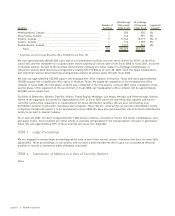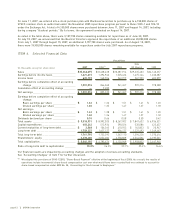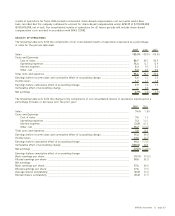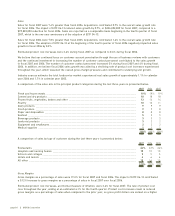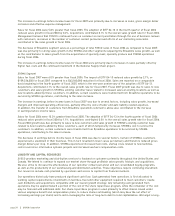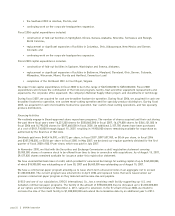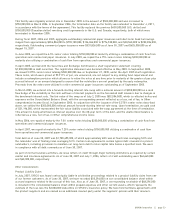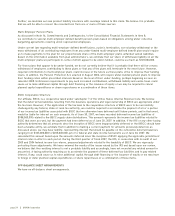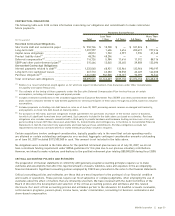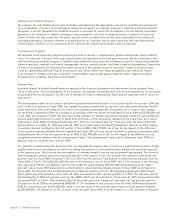Sysco 2007 Annual Report Download - page 43
Download and view the complete annual report
Please find page 43 of the 2007 Sysco annual report below. You can navigate through the pages in the report by either clicking on the pages listed below, or by using the keyword search tool below to find specific information within the annual report.sales dollars base. However, the company was able to manage this inflationary environment well resulting in gross profit
dollars increasing 7.4% for the year.
Gross margins as a percentage of sales were 19.3% for fiscal 2006, as compared to 19.1% for fiscal 2005. The adoption of
EITF 04-13 in the fourth quarter of fiscal 2006 contributed 0.06% to the increase in gross margins as a percentage of sales
in fiscal 2006 over fiscal 2005. Management believes that the remaining gross margin increase as a percentage of sales
was aided by several factors, including low product cost inflation and effective merchandising.
While we can not predict if product cost inflation will continue in future periods, in general, we believe prolonged periods
of high inflation may have a negative impact on our customers and as a result, on our sales, gross margins and earnings.
Operating Expenses
Operating expenses include the costs of warehousing and delivering products as well as selling, administrative and
occupancy expenses.
Operating expenses as a percentage of sales were 14.4% for fiscal 2007, as compared to 14.7% for fiscal 2006. The impact
of EITF 04-13 increased operating expenses as a percentage of sales by 0.09% for fiscal 2007 as compared to fiscal 2006.
The decline in operating expenses as a percentage of sales, prior to the effect of the impact of EITF 04-13, was primarily
due to efficiencies obtained at the operating company level. Decreases in pension and share-based compensation
expenses and higher gains related to the cash surrender value of corporate-owned life insurance policies were largely
offset by increased management incentive bonus accruals and investments in strategic business initiatives.
Share-based compensation expense decreased $28,852,000 in fiscal 2007 over the prior year, due primarily to the
completion of expense recognition in fiscal 2006 of a significant number of options granted in fiscal 2002. Net pension
costs decreased $56,001,000 in fiscal 2007 over the prior year, due primarily to the increase in the discount rate used
to determine fiscal 2007 pension costs.
Operating expenses were reduced by the recognition of a gain of $23,922,000 in fiscal 2007 to adjust the carrying value
of life insurance assets to their cash surrender value. This compared to the recognition of a gain of $9,702,000 in fiscal 2006.
Due primarily to improved operating results, the non-stock portion of management incentive bonus accruals increased
$64,770,000 in fiscal 2007 compared to fiscal 2006 when our performance did not satisfy the criteria for paying bonuses to
our corporate officers. Investments in strategic business initiatives increased $22,410,000 in fiscal 2007 over the prior year.
Operating expenses as a percentage of sales were 14.7% for fiscal 2006, as compared to 13.9% for fiscal 2005. The impact
of EITF 04-13 for the fourth quarter of fiscal 2006 increased operating expenses as a percentage of sales by 0.04% for
fiscal 2006. The increase in operating expenses as a percentage of sales included incremental share-based compensation,
increased fuel costs, increased pension costs and increased expenses associated with the National Supply Chain project,
partially offset by reduced management incentive bonus accruals.
Share-based compensation expense increased $107,088,000 in fiscal 2006 over the prior year, resulting from incremental
expense incurred due to the adoption of SFAS 123(R) (See Note 13 to the consolidated financial statements in Item 8). Fuel
costs increased $48,600,000 in fiscal 2006 over the prior year. Net pension costs increased $23,734,000 in fiscal 2006 over
the prior year. Operating expenses were reduced by the recognition of a gain of $9,702,000 in fiscal 2006 to adjust the
carrying value of life insurance assets to their cash surrender value, as compared to a gain of $13,803,000 in fiscal 2005.
The non-stock portion of various management incentive bonus accruals decreased $18,216,000 in fiscal 2006 as compared
to fiscal 2005.
Net pension costs in fiscal 2008 are expected to decrease by approximately $9,000,000 due primarily to the funding status
and asset performance of the qualified pension plan.
Interest Expense
The decrease in interest expense of $4,098,000 in fiscal 2007 as compared to fiscal 2006 was primarily due to decreased
borrowing levels.
The increase in interest expense of $34,100,000 in fiscal 2006 over fiscal 2005 was due to a combination of increased
borrowing rates and increased borrowing levels. In fiscal 2006, commercial paper and short-term bank borrowing rates
increased over the prior year. Effective borrowing rates on long-term debt also increased over fiscal 2005. In fiscal 2005,
SYSCO Corporation ][ page 17





